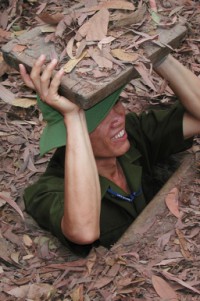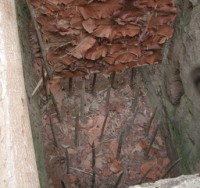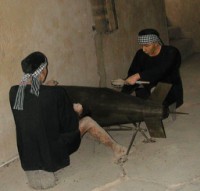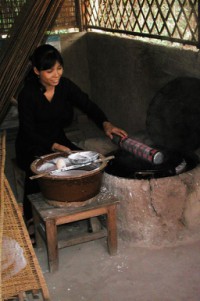I kept lousy notes of this trip; I'm not exactly certain what day we toured the tunnels, or where we rode that day—I think we were actually bussed to the site. At any rate, among the clever things the American military did during the war was build a military base atop a secret network of enemy tunnels leftover from fighting the French. These tunnels are located outside of Saigon, and go for miles.
We started out by watching a hoary old 1967 black and white propaganda film, so worn I could barely make out the commentary about the gentle peaceful villagers cruelly attacked by evil American soldiers. Propaganda is universal in its style, I guess; this reminded me nothing so much of those atomic bomb thingies we had to watch as grade school children. At any rate, I thought it was interesting for the era it evoked. Simple peasants or not, people can become incredibly resourceful when they feel their homes and lives are at stake; the amount of effort and ingenuity that went into these tunnels—even into the dioramas, below—is truly astonishing.
In the interest of giving fat foreigners a taste of crawling around in dark, cramped holes in the ground, they've enlarged a couple, with periodic openings. Even so, I had to crawl on my hands and knees, and didn't feel there was any room to spare. I can't truly imagine what it must've been like to live in these things, without lights, without maps —either to keep from getting lost or to keep from encountering the many traps—for days at a time. Even the tourist version was daunting enough that only the youngest two members of the group went the whole 100 meter distance.

Our guide started out by allowing us the opportunity to see if we could spot a tunnel opening. We all failed. I know the wizard used to sneak back in his parents’ house as a teenager via the milk chute, so I wasn't totally surprised when our guide, who has what I would consider a typical Vietnamese build, fit inside.

Patrick, however, is probably close to six feet tall, and he managed the unenlarged opening too. I was pretty impressed by this feat. He, um, defended the honor of our group by being one of two people willing to attempt this; he also crawled the whole distance of the “tourist†tunnel. And he's photogenic:)

Ouch! This was only one of 5 or 10 variations showcased on this theme of sharped, spiky ends waiting for the American ‘tunnel rats’; my mom's no doubt correct theory was that the Vietnamese simply adapted traps for capturing food.

These are not people, but incredibly sophisticated automata. I was very impressed with the ingenuity of these wind up figures.

Unfortunately the picture cuts off most the drying platform (complete with an earlier tourist effort) for these round rice sheets, which usually holds four in a line; people still make their own (well, they still go to market every day to buy food, too). I would see these bamboo drying racks in the courtyard area, as I rode along, all over the country (Vietnamese homes may be nestled away from the road; but if close to it, the front area is often paved, perhaps enclosed by a wall, and used for drying rice and the like, rather than planted with the grass and landscapting typical of North American homes.) .
Similar in technique to Ethiopian injera or French crepes, the process is as follows: dip a small ladleful (perhaps 2 or 3 Tablespoons) of batter and pour onto a hot, flat pan (which shows poorly in the photo); roll up the resulting rice pancake off the pan with the cloth covered cylinder; then roll out the damp flatbread onto a woven bamboo drying rack. They're quite fragile at this point, and easily prone to wrinkling: it would be nearly impossible to remove them with a spatula. The smiling cook invited us to try making one.
Some of the guys took the opportunity to fire AK-47s at a dollarUSD a round; having wimped out on this golden opportunity, I took her up on this more girly task in lieu. Mine was almost useable, given the expert's guidance as to how much batter to pour on the grill, how long to let it fry before rolling it onto the roller and transferring it to the rack. I figured I could probably make acceptable ones after the first hundred or so, though it would more likely take a thousand or more to become really expert.
Next time: Rolling down that Highway; or back to the Giac Lam Pagoda; or return to the Vietnam index
Unless otherwise noted, text, image and objects depicted therein copyright 1996--present sylvus tarn.
Sylvus Tarn